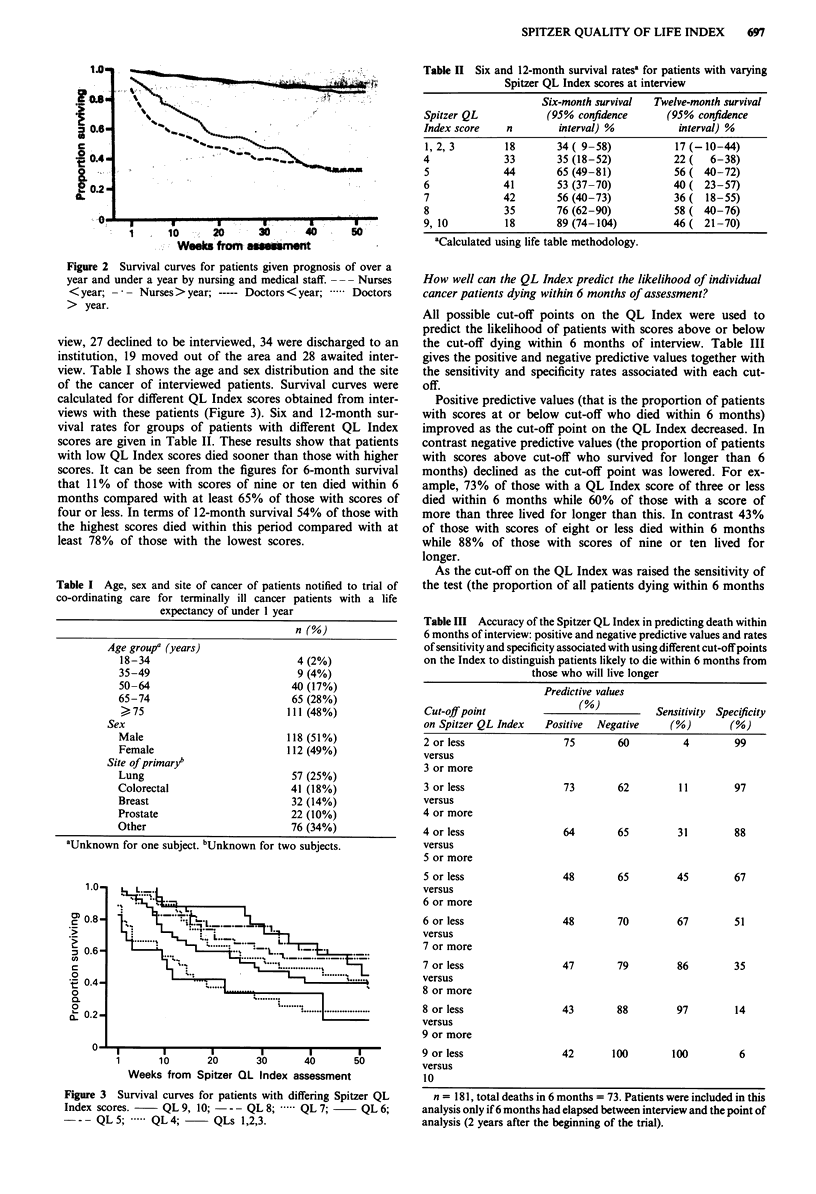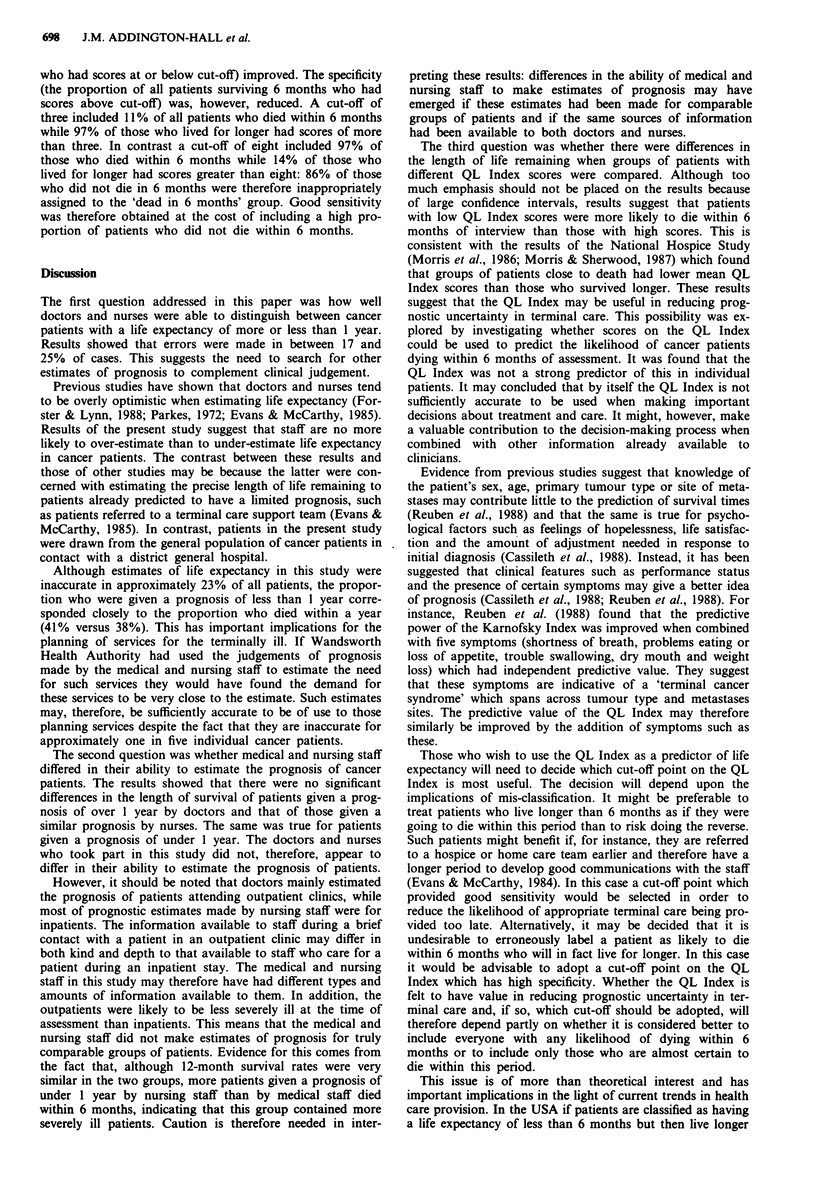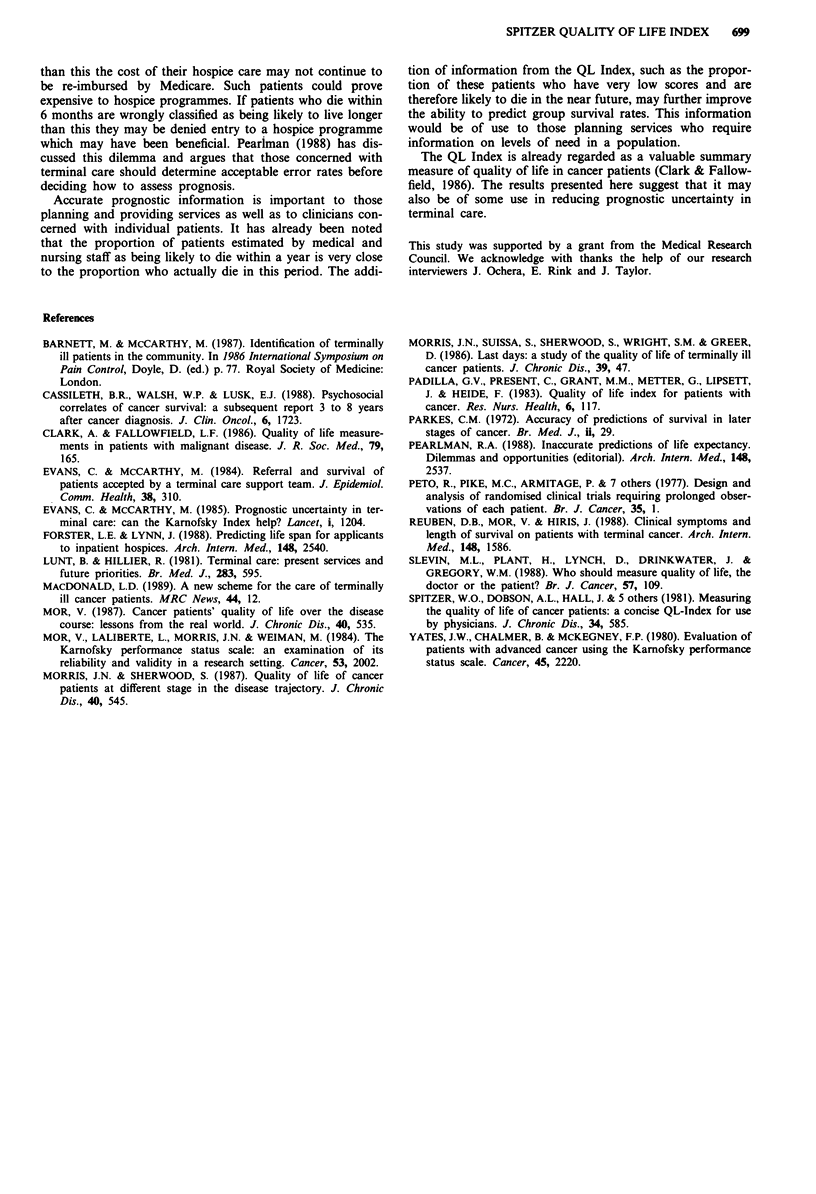Abstract
Data from an on-going trial of co-ordinating care for terminally ill cancer patients are used to investigate whether the Spitzer Quality of Life (QL) Index can be used to reduce prognostic uncertainty in terminal care. Four questions are addressed. First, can doctors and nurses distinguish between patients with a prognosis of more or less than 1 year? Second, do the medical and nursing staff differ in their ability to estimate prognosis? Third, are there differences in the length of life remaining between groups of patients with different QL Index scores? Fourth, how well does the QL Index predict the likelihood of individual patients dying within 6 months of assessment? Doctors and nurses assigned between 17 and 25% of patients to the wrong prognostic group and were as likely to over-estimate as to under-estimate life expectancy. Medical and nursing staff did not differ in their ability to make prognostic judgements. Patients with a low QL Index score were more likely to die within 6 months than those with higher scores, but scores on the Index were not strong predictors of 6-month survival in individual patients. The Index is not accurate enough to be used to predict what sort of treatment terminally ill patients will require in the future and for how long. Nevertheless, it may prove valuable for those planning services for terminally ill cancer patients who require information on the levels of need in a population.
Full text
PDF




Selected References
These references are in PubMed. This may not be the complete list of references from this article.
- Clark A., Fallowfield L. J. Quality of life measurements in patients with malignant disease: a review. J R Soc Med. 1986 Mar;79(3):165–169. doi: 10.1177/014107688607900311. [DOI] [PMC free article] [PubMed] [Google Scholar]
- Evans C., McCarthy M. Prognostic uncertainty in terminal care: can the Karnofsky index help? Lancet. 1985 May 25;1(8439):1204–1206. doi: 10.1016/s0140-6736(85)92876-4. [DOI] [PubMed] [Google Scholar]
- Evans C., McCarthy M. Referral and survival of patients accepted by a terminal care support team. J Epidemiol Community Health. 1984 Dec;38(4):310–314. doi: 10.1136/jech.38.4.310. [DOI] [PMC free article] [PubMed] [Google Scholar]
- Forster L. E., Lynn J. Predicting life span for applicants to inpatient hospice. Arch Intern Med. 1988 Dec;148(12):2540–2543. [PubMed] [Google Scholar]
- Lunt B., Hillier R. Terminal care: present services and future priorities. Br Med J (Clin Res Ed) 1981 Aug 29;283(6291):595–598. doi: 10.1136/bmj.283.6291.595. [DOI] [PMC free article] [PubMed] [Google Scholar]
- Mor V. Cancer patients' quality of life over the disease course: lessons from the real world. J Chronic Dis. 1987;40(6):535–544. doi: 10.1016/0021-9681(87)90011-7. [DOI] [PubMed] [Google Scholar]
- Mor V., Laliberte L., Morris J. N., Wiemann M. The Karnofsky Performance Status Scale. An examination of its reliability and validity in a research setting. Cancer. 1984 May 1;53(9):2002–2007. doi: 10.1002/1097-0142(19840501)53:9<2002::aid-cncr2820530933>3.0.co;2-w. [DOI] [PubMed] [Google Scholar]
- Morris J. N., Sherwood S. Quality of life of cancer patients at different stages in the disease trajectory. J Chronic Dis. 1987;40(6):545–556. doi: 10.1016/0021-9681(87)90012-9. [DOI] [PubMed] [Google Scholar]
- Morris J. N., Suissa S., Sherwood S., Wright S. M., Greer D. Last days: a study of the quality of life of terminally ill cancer patients. J Chronic Dis. 1986;39(1):47–62. doi: 10.1016/0021-9681(86)90106-2. [DOI] [PubMed] [Google Scholar]
- Padilla G. V., Presant C., Grant M. M., Metter G., Lipsett J., Heide F. Quality of life index for patients with cancer. Res Nurs Health. 1983 Sep;6(3):117–126. doi: 10.1002/nur.4770060305. [DOI] [PubMed] [Google Scholar]
- Parkes C. M. Accuracy of predictions of survival in later stages of cancer. Br Med J. 1972 Apr 1;2(5804):29–31. doi: 10.1136/bmj.2.5804.29. [DOI] [PMC free article] [PubMed] [Google Scholar]
- Pearlman R. A. Inaccurate predictions of life expectancy. Dilemmas and opportunities. Arch Intern Med. 1988 Dec;148(12):2537–2538. doi: 10.1001/archinte.148.12.2537. [DOI] [PubMed] [Google Scholar]
- Reuben D. B., Mor V., Hiris J. Clinical symptoms and length of survival in patients with terminal cancer. Arch Intern Med. 1988 Jul;148(7):1586–1591. [PubMed] [Google Scholar]
- Slevin M. L., Plant H., Lynch D., Drinkwater J., Gregory W. M. Who should measure quality of life, the doctor or the patient? Br J Cancer. 1988 Jan;57(1):109–112. doi: 10.1038/bjc.1988.20. [DOI] [PMC free article] [PubMed] [Google Scholar]
- Spitzer W. O., Dobson A. J., Hall J., Chesterman E., Levi J., Shepherd R., Battista R. N., Catchlove B. R. Measuring the quality of life of cancer patients: a concise QL-index for use by physicians. J Chronic Dis. 1981;34(12):585–597. doi: 10.1016/0021-9681(81)90058-8. [DOI] [PubMed] [Google Scholar]
- Yates J. W., Chalmer B., McKegney F. P. Evaluation of patients with advanced cancer using the Karnofsky performance status. Cancer. 1980 Apr 15;45(8):2220–2224. doi: 10.1002/1097-0142(19800415)45:8<2220::aid-cncr2820450835>3.0.co;2-q. [DOI] [PubMed] [Google Scholar]


